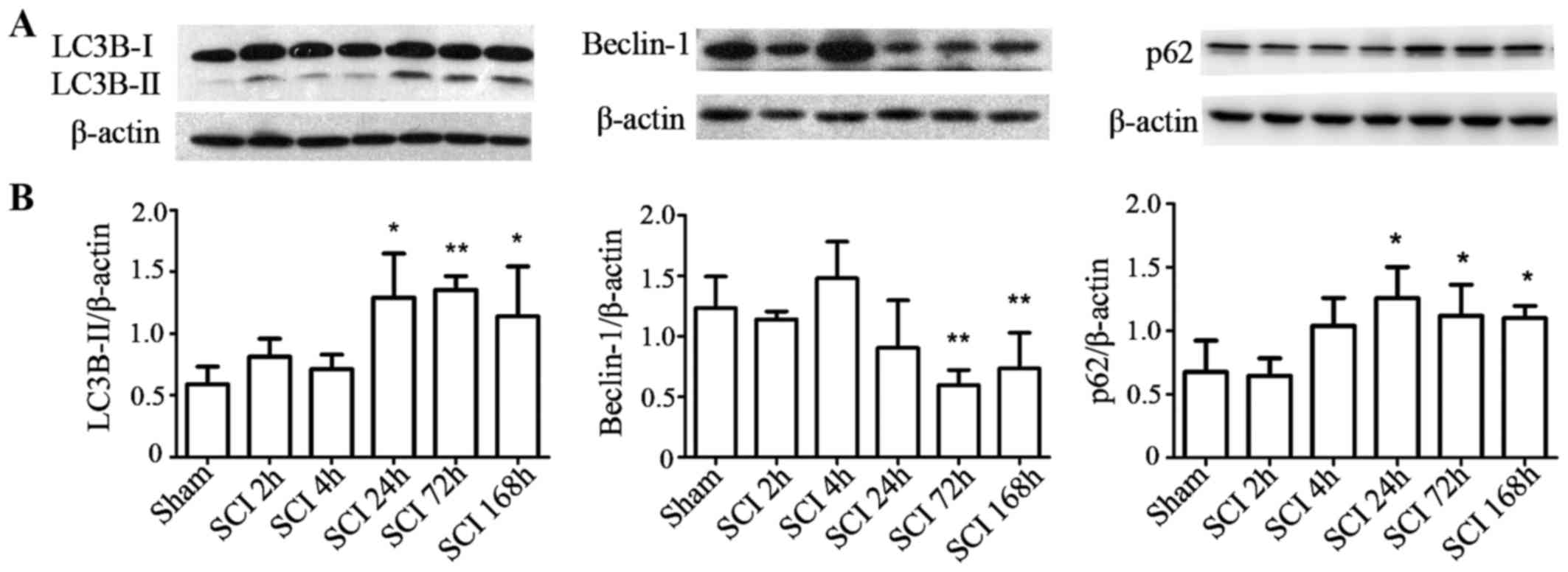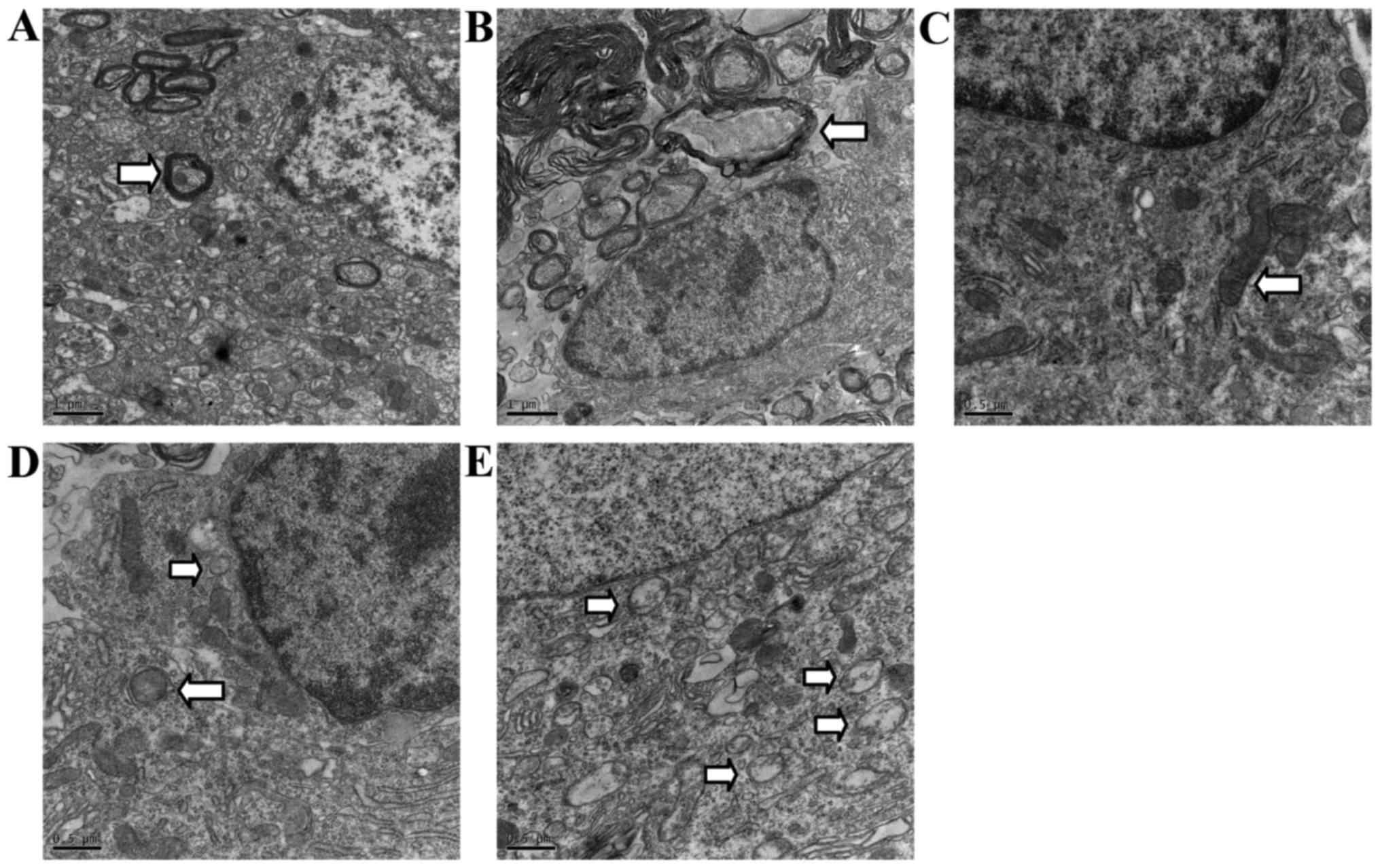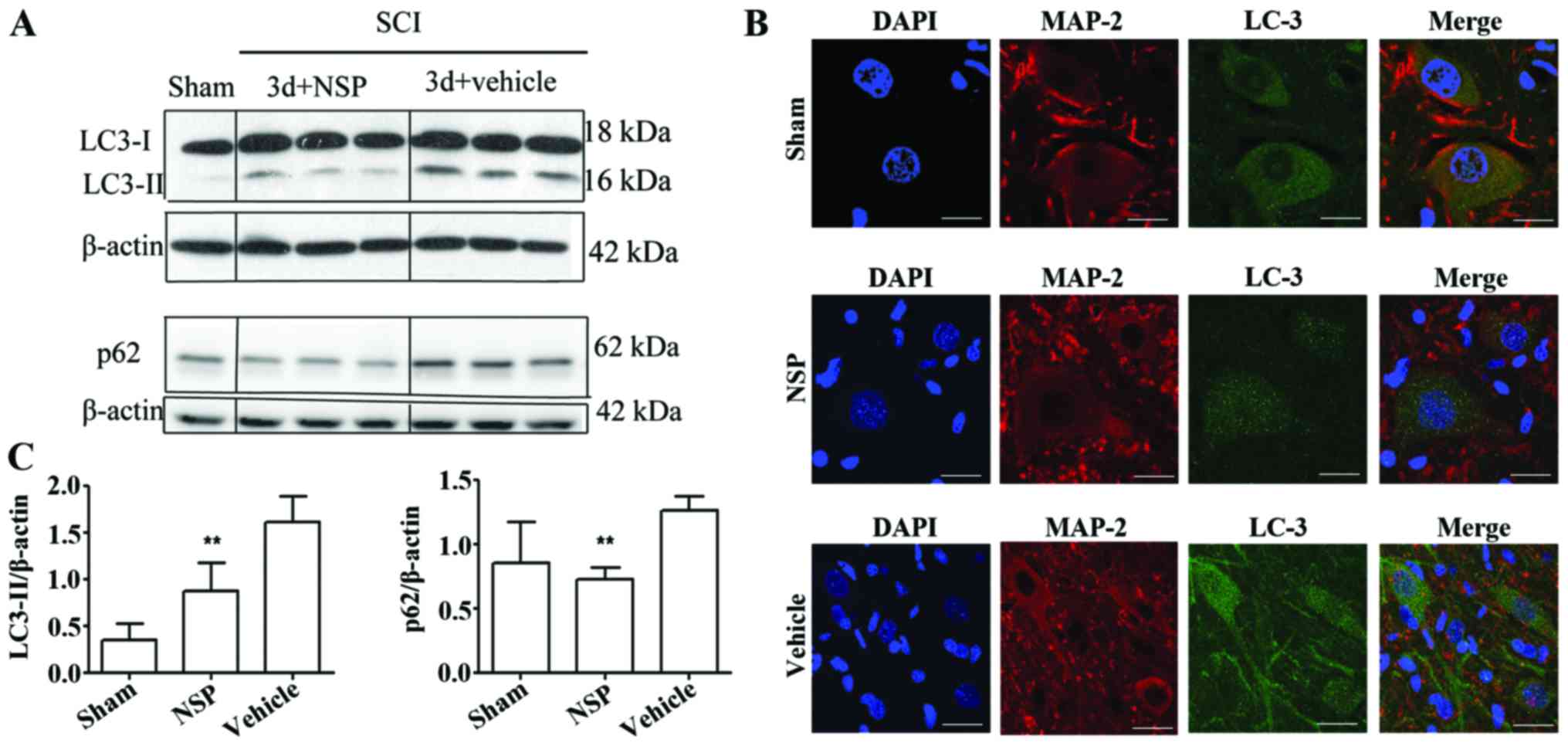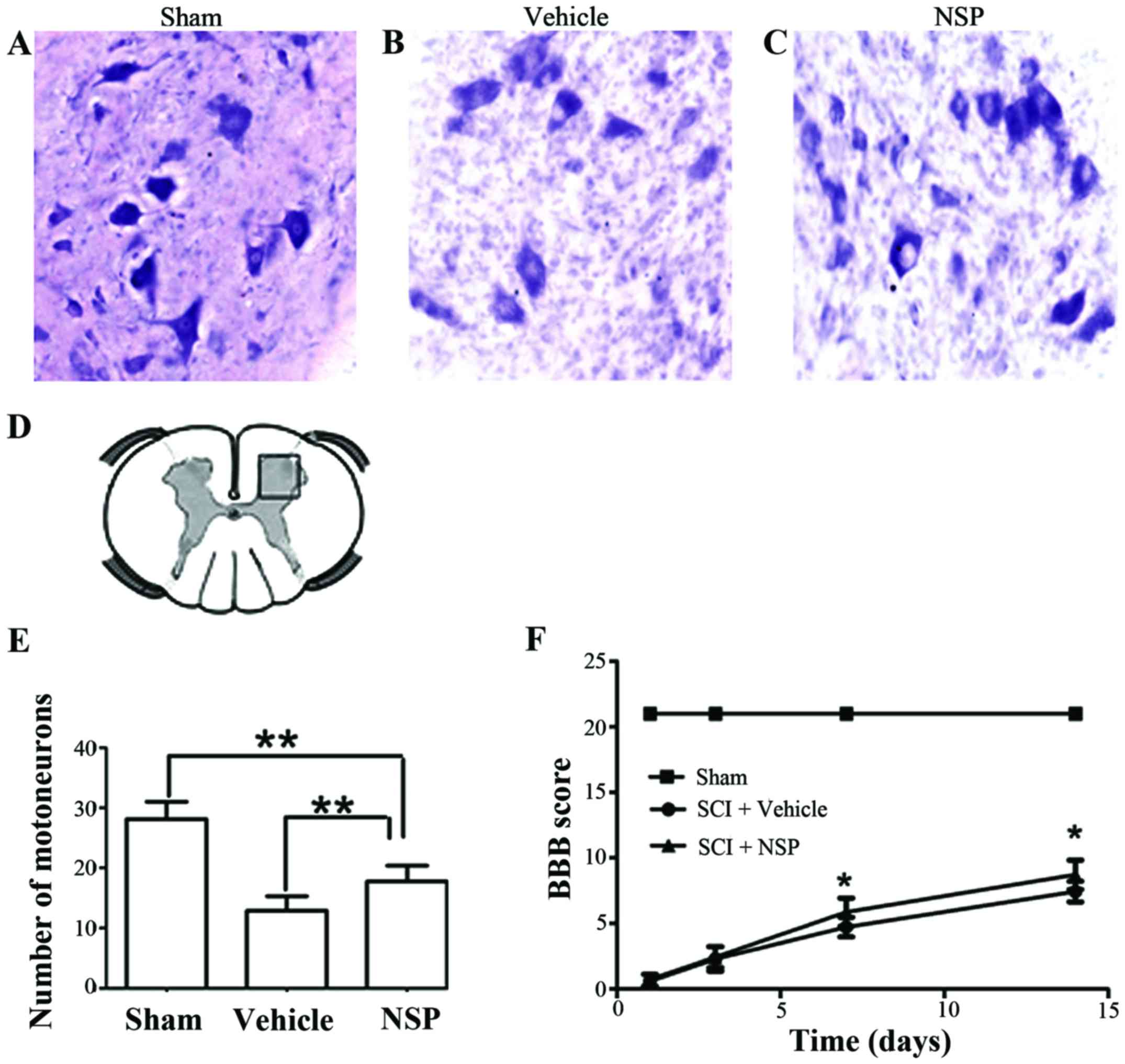|
1
|
Kwon BK, Tetzlaff W, Grauer JN, Beiner J
and Vaccaro AR: Pathophysiology and pharmacologic treatment of
acute spinal cord injury. Spine J. 4:451–464. 2004. View Article : Google Scholar : PubMed/NCBI
|
|
2
|
Yu WY and He DW: Current trends in spinal
cord injury repair. Eur Rev Med Pharmacol Sci. 19:3340–3344.
2015.PubMed/NCBI
|
|
3
|
Thuret S, Moon LD and Gage FH: Therapeutic
interventions after spinal cord injury. Nat Rev Neurosci.
7:628–643. 2006. View
Article : Google Scholar : PubMed/NCBI
|
|
4
|
Varma AK, Das A, Wallace G IV, Barry J,
Vertegel AA, Ray SK and Banik NL: Spinal cord injury: A review of
current therapy, future treatments, and basic science frontiers.
Neurochem Res. 38:895–905. 2013. View Article : Google Scholar : PubMed/NCBI
|
|
5
|
Mizushima N: Autophagy: Process and
function. Genes Dev. 21:2861–2873. 2007. View Article : Google Scholar : PubMed/NCBI
|
|
6
|
Wang ZY, Lin JH, Muharram A and Liu WG:
Beclin-1-mediated autophagy protects spinal cord neurons against
mechanical injury-induced apoptosis. Apoptosis. 19:933–945. 2014.
View Article : Google Scholar : PubMed/NCBI
|
|
7
|
Tang P, Hou H and Zhang L, Lan X, Mao Z,
Liu D, He C, Du H and Zhang L: Autophagy reduces neuronal damage
and promotes locomotor recovery via inhibition of apoptosis after
spinal cord injury in rats. Mol Neurobiol. 49:276–287. 2014.
View Article : Google Scholar : PubMed/NCBI
|
|
8
|
Liu S, Sarkar C, Dinizo M, Faden AI, Koh
EY, Lipinski MM and Wu J: Disrupted autophagy after spinal cord
injury is associated with ER stress and neuronal cell death. Cell
Death Dis. 6:e15822015. View Article : Google Scholar : PubMed/NCBI
|
|
9
|
Kanno H, Ozawa H, Sekiguchi A and Itoi E:
Spinal cord injury induces upregulation of Beclin 1 and promotes
autophagic cell death. Neurobiol Dis. 33:143–148. 2009. View Article : Google Scholar : PubMed/NCBI
|
|
10
|
Sekiguchi A, Kanno H, Ozawa H, Yamaya S
and Itoi E: Rapamycin promotes autophagy and reduces neural tissue
damage and locomotor impairment after spinal cord injury in mice. J
Neurotrauma. 29:946–956. 2012. View Article : Google Scholar : PubMed/NCBI
|
|
11
|
Miranda E and Lomas DA: Neuroserpin: A
serpin to think about. Cell Mol Life Sci. 63:709–722. 2006.
View Article : Google Scholar : PubMed/NCBI
|
|
12
|
Wan S, Feng Z, Chen Z, Wang X, Cao Y, Shao
Y and Jiang X: Neuroserpin upregulates in the early period of
sustained spinal cord compression. Clin Lab. 58:891–896.
2012.PubMed/NCBI
|
|
13
|
Wu J, Echeverry R, Guzman J and Yepes M:
Neuroserpin protects neurons from ischemia-induced plasmin-mediated
cell death independently of tissue-type plasminogen activator
inhibition. Am J Pathol. 177:2576–2584. 2010. View Article : Google Scholar : PubMed/NCBI
|
|
14
|
Yepes M, Sandkvist M, Wong MK, Coleman TA,
Smith E, Cohan SL and Lawrence DA: Neuroserpin reduces cerebral
infarct volume and protects neurons from ischemia-induced
apoptosis. Blood. 96:569–576. 2000.PubMed/NCBI
|
|
15
|
Rivlin AS and Tator CH: Effect of duration
of acute spinal cord compression in a new acute cord injury model
in the rat. Surg Neurol. 10:38–43. 1978.PubMed/NCBI
|
|
16
|
von Euler M, Seiger A and Sundström E:
Clip compression injury in the spinal cord: A correlative study of
neurological and morphological alterations. Exp Neurol.
145:502–510. 1997. View Article : Google Scholar : PubMed/NCBI
|
|
17
|
Zhang HY, Wang ZG, Wu FZ, Kong XX, Yang J,
Lin BB, Zhu SP, Lin L, Gan CS, Fu XB, et al: Regulation of
autophagy and ubiquitinated protein accumulation by bFGF promotes
functional recovery and neural protection in a rat model of spinal
cord injury. Mol Neurobiol. 48:452–464. 2013. View Article : Google Scholar : PubMed/NCBI
|
|
18
|
Nixon RA: The role of autophagy in
neurodegenerative disease. Nat Med. 19:983–997. 2013. View Article : Google Scholar : PubMed/NCBI
|
|
19
|
Luo CL, Li BX, Li QQ, Chen XP, Sun YX, Bao
HJ, Dai DK, Shen YW, Xu HF, Ni H, et al: Autophagy is involved in
traumatic brain injury-induced cell death and contributes to
functional outcome deficits in mice. Neuroscience. 184:54–63. 2011.
View Article : Google Scholar : PubMed/NCBI
|
|
20
|
Ghavami S, Shojaei S, Yeganeh B, Ande SR,
Jangamreddy JR, Mehrpour M, Christoffersson J, Chaabane W, Moghadam
AR, Kashani HH, et al: Autophagy and apoptosis dysfunction in
neurodegenerative disorders. Prog Neurobiol. 112:24–49. 2014.
View Article : Google Scholar : PubMed/NCBI
|
|
21
|
Smith CM, Chen Y, Sullivan ML, Kochanek PM
and Clark RS: Autophagy in acute brain injury: Feast, famine, or
folly? Neurobiol Dis. 43:52–59. 2011. View Article : Google Scholar : PubMed/NCBI
|
|
22
|
Chen HC, Fong TH, Lee AW and Chiu WT:
Autophagy is activated in injured neurons and inhibited by
methylprednisolone after experimental spinal cord injury. Spine
(Phila Pa 1976). 37:470–475. 2012. View Article : Google Scholar : PubMed/NCBI
|
|
23
|
Kang R, Zeh HJ, Lotze MT and Tang D: The
Beclin 1 network regulates autophagy and apoptosis. Cell Death
Differ. 18:571–580. 2011. View Article : Google Scholar : PubMed/NCBI
|
|
24
|
Tanabe F, Yone K, Kawabata N, Sakakima H,
Matsuda F, Ishidou Y, Maeda S, Abematsu M, Komiya S and Setoguchi
T: Accumulation of p62 in degenerated spinal cord under chronic
mechanical compression: Functional analysis of p62 and autophagy in
hypoxic neuronal cells. Autophagy. 7:1462–1471. 2011. View Article : Google Scholar : PubMed/NCBI
|
|
25
|
Gurusamy N and Das DK: Detection of cell
death by autophagy. Methods Mol Biol. 559:95–103. 2009. View Article : Google Scholar : PubMed/NCBI
|
|
26
|
Zhang Z, Zhang L, Yepes M, Jiang Q, Li Q,
Arniego P, Coleman TA, Lawrence DA and Chopp M: Adjuvant treatment
with neuroserpin increases the therapeutic window for tissue-type
plasminogen activator administration in a rat model of embolic
stroke. Circulation. 106:740–745. 2002. View Article : Google Scholar : PubMed/NCBI
|
|
27
|
Lv YC, Shi DY, Jiang XX, Feng ZZ, Jiang C
and Chen ZX: Repair effects of neuroserpin (NSP) on neural function
after acute spinal cord injury (SCI) in rats. Fudan Univ J Med Sci.
41:216–221. 2014.(In Chinese).
|














